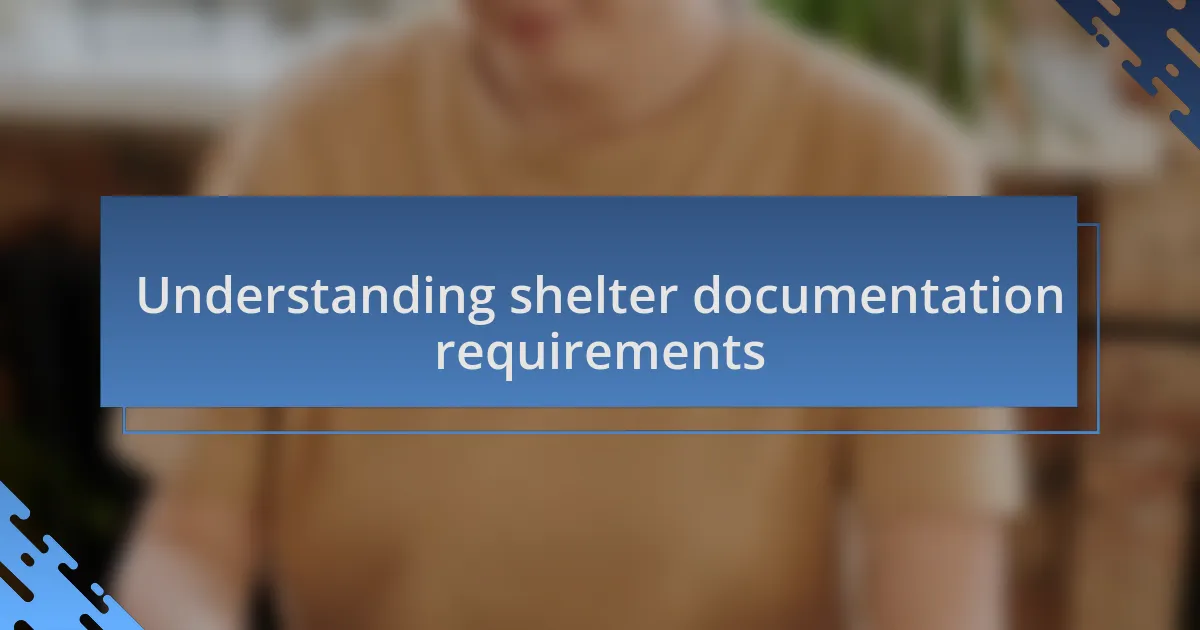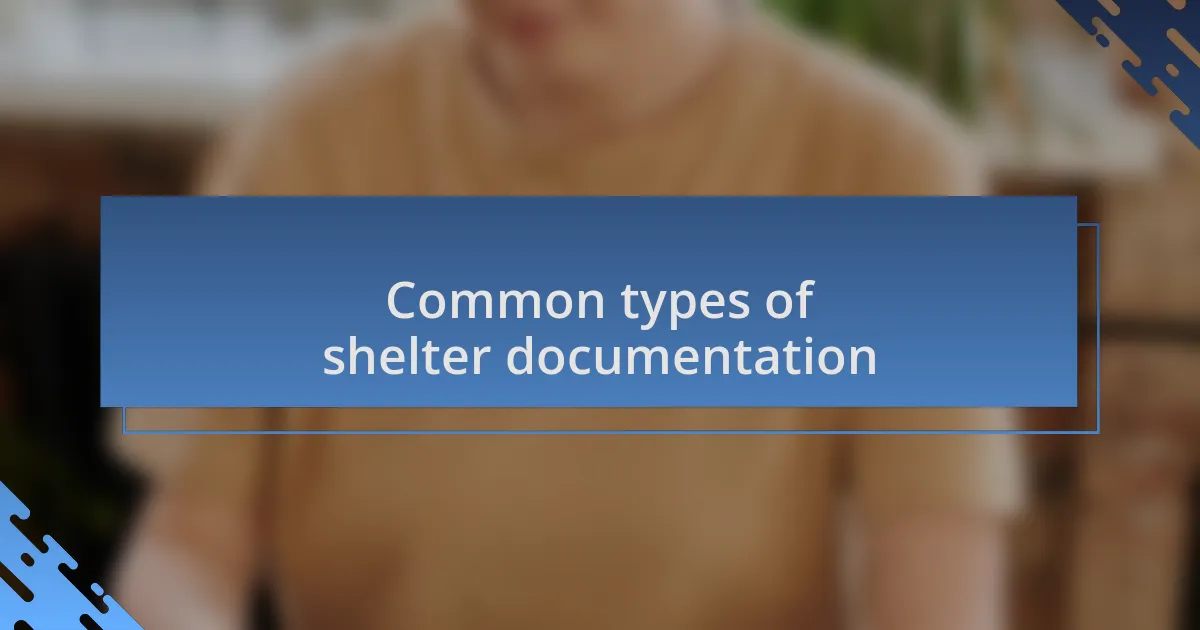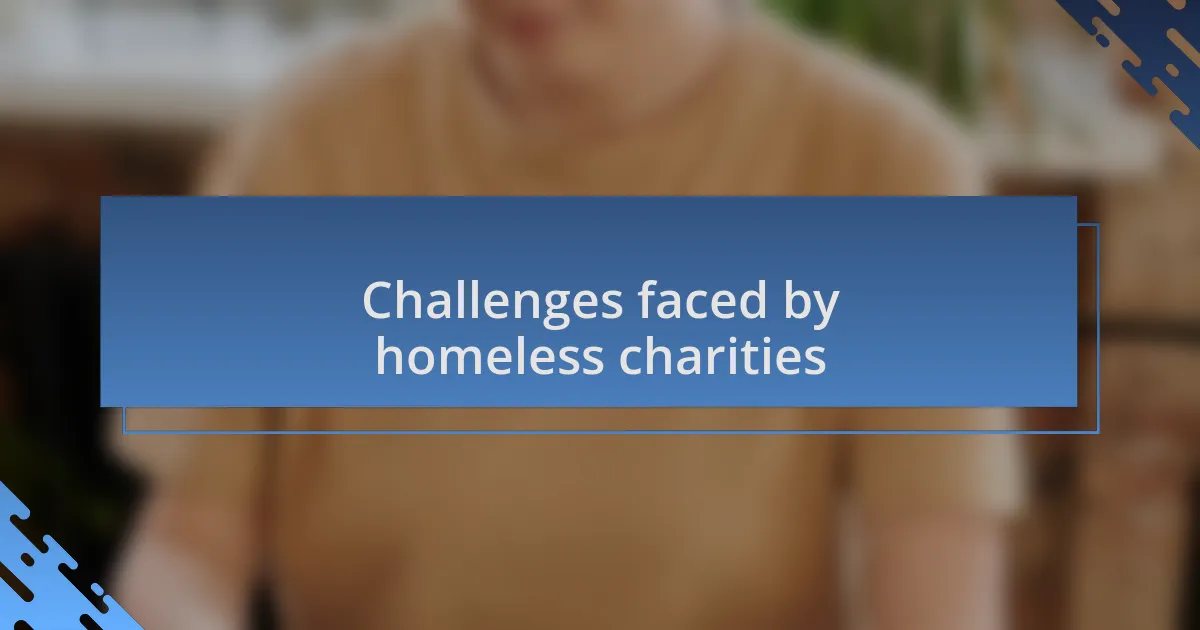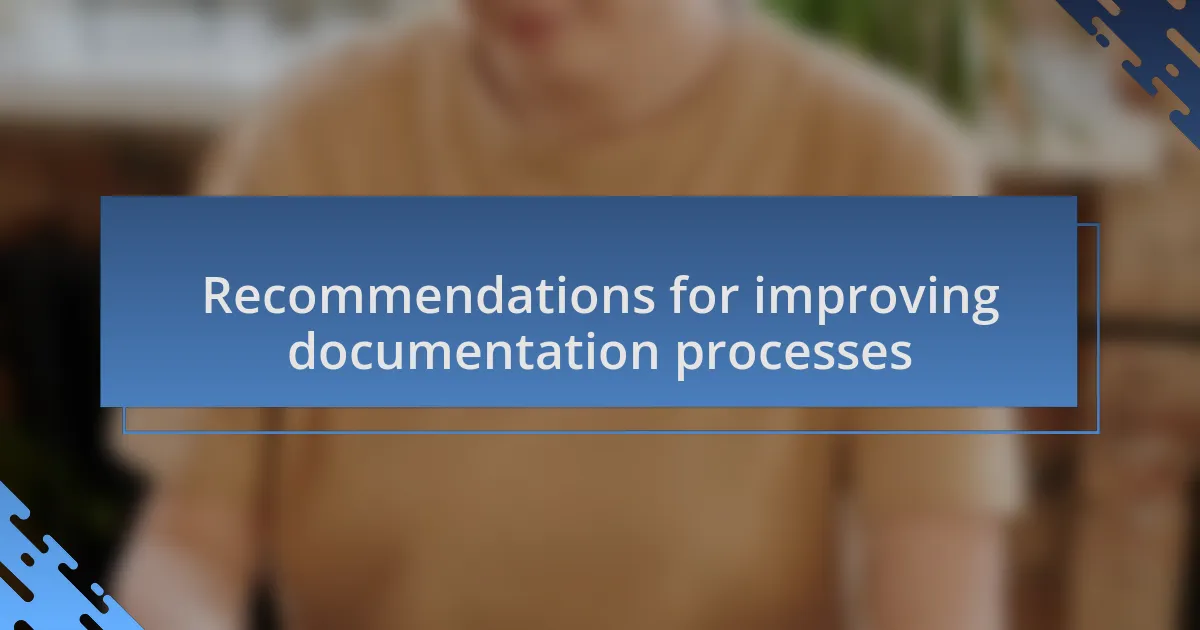Key takeaways:
- Documentation is essential for accessing shelter services, often serving as a barrier that can hinder individuals from receiving the support they need.
- Common documentation requirements include proof of identity, residence, and references, which can evoke emotional challenges for individuals experiencing homelessness.
- Homeless charities face significant challenges, such as funding shortages and bureaucratic hurdles, impacting their ability to assist clients effectively.
- Improving documentation processes through digital tools, open communication, and client feedback can enhance accessibility and support for those in need.

Understanding shelter documentation requirements
When it comes to shelter documentation, I’ve often found that the process can feel overwhelming for those in need. It’s not just about collecting paperwork; it’s about proving one’s circumstances, and this can be deeply emotional for many. Think about it: how would you feel if your sense of security depended on documents that might not even capture the full story of your life?
I remember a time when I was assisting an individual seeking shelter who had misplaced their identification. The anxiety on their face was palpable, and it made me realize how vital clear documentation is for accessing services. It’s not just a formality; it’s a gateway to stability, and navigating these requirements can often be a barrier rather than a bridge.
One critical aspect is understanding what specific documents are required. I often encourage people to ask themselves: Do I have proof of income, identification, or a rental history? These aren’t merely bureaucratic hoops; they reflect real-life experiences and challenges that can significantly affect how quickly someone receives help and feels supported in their journey.

Importance of documentation in shelters
Documentation in shelters serves as a crucial bridge to resources, often determining the speed and type of assistance someone receives. I’ve seen firsthand how missing paperwork can delay access to essential services, leaving individuals feeling helpless and frustrated. It raises the question: how many people might slip through the cracks simply because of an unavailability of documentation?
During one outreach effort, a young mother shared her struggle with finding shelter because she lacked recent pay stubs. She had been working hard to provide for her children but felt that without that one document, she was unworthy of assistance. This experience highlighted to me that documentation is not just about policies; it’s a reflection of one’s effort and desire for stability.
Moreover, proper documentation can enhance a shelter’s ability to track and report outcomes, which ultimately leads to improved services. I remember a conversation with a shelter director who emphasized that comprehensive records help identify trends and gaps in services. It made me think: when shelters can better understand the needs of their residents, aren’t we collectively working towards a more effective support system for those experiencing homelessness?

Common types of shelter documentation
When discussing common types of shelter documentation, it’s essential to recognize that the requirements vary significantly from one facility to another. Typically, proof of identity, such as a government-issued ID or passport, is a fundamental requirement. In my experience, I’ve witnessed individuals become anxious when they realize they’ve lost their ID, as they feel it places them at a severe disadvantage in accessing help.
Another common document needed is proof of residence or homelessness. This can include letters from previous landlords, utility bills, or confirmation from social services. I remember a poignant encounter with a man who shared his difficulty in obtaining a shelter bed because he had not kept old utilities bills. He reflected on how this simple oversight made him feel even more marginalized, highlighting the emotional toll that the paperwork can have in moments of vulnerability.
Additionally, some shelters ask for references or letters from caseworkers in order to corroborate an individual’s story. This often acts as a double-edged sword; while it can streamline the process for those in the system, those without established support networks might feel alienated. It made me think: how can we bridge this gap to ensure everyone has a fair chance at receiving assistance? It’s clear that while these documentation types are necessary, the emotional ramifications can be significant.

Challenges faced by homeless charities
One major challenge faced by homeless charities is the constant struggle for funding. Many organizations rely heavily on donations, but as I’ve observed firsthand, economic downturns can drastically reduce available resources. It’s disheartening to see dedicated teams stretched thin while trying to deliver essential services, often resulting in burnout among staff who genuinely care for those they serve.
Furthermore, the fluctuating demand for services creates a logistical nightmare. I recall a particular winter when one charity I worked with experienced an unexpected surge in individuals seeking shelter. They had to scramble to source additional bedding and food, all while keeping their regular operations running smoothly. This unpredictability not only strains resources but also affects the emotional state of both workers and clients, who find stability elusive amid such chaos.
Finally, navigating bureaucratic red tape can slow progress and reduce the effectiveness of outreach efforts. In my interactions with various charities, I’ve seen how complex application processes can discourage individuals from seeking help. It makes me wonder: how many people fall through the cracks simply because they find the system too daunting to engage with? Overcoming these challenges requires creative solutions and a commitment to ensuring that help is accessible to all in need.

Personal experiences with documentation issues
When I volunteered at a shelter, I vividly remember a woman named Sarah, who had been living on the streets for months. She finally mustered the courage to seek assistance but was turned away because she didn’t have the right identification papers. It struck me how something as seemingly simple as documentation could perpetuate someone’s struggle. How many others like Sarah are out there, quietly suffering due to a lack of necessary paperwork?
Another instance involved a young man I met who was desperate for help but found himself entangled in an overwhelming bureaucracy. He had the needed forms for housing assistance but faced a maze of requirements that seemed to change daily. Watching his frustration grow made me realize just how intimidating the process can be. Why should basic help feel like a daunting obstacle course?
There was also a time when I assisted an elderly gentleman who had lost his identification while moving between shelters. As we tried to get him re-established, I could see the fear in his eyes—the fear of being judged for not having his documentation in order. It was a stark reminder that, often, more than just paperwork stands in the way of securing safety and stability. How often do we overlook the emotional toll these challenges take on individuals?

Best practices for organizing documentation
Organizing documentation can feel overwhelming, especially for those seeking shelter. In my experience, creating a clear filing system is essential. I often saw volunteers labeling folders for each individual, categorizing them by type of document—IDs, applications, and support letters. This simple practice made it easier for staff to find necessary paperwork quickly, reducing wait times for those in need.
Another effective approach is maintaining a checklist of required documents for clients. When I first encountered this idea during an organization meeting, it seemed so basic yet transformative. Clients can track what they have and what they still need to gather, making the process feel less daunting and more manageable. This proactive strategy allows individuals to take charge of their situation, fostering a sense of empowerment amidst the chaos.
Finally, regular training sessions for staff on the importance of documentation organization can make a big difference. I’ve seen how dedicating time to refresh our understanding of policy changes ensures everyone is on the same page. When staff feel confident addressing documentation needs, it translates into a smoother experience for clients. Don’t we all deserve a helping hand that doesn’t feel like an uphill battle?

Recommendations for improving documentation processes
One recommendation for improving documentation processes is to introduce digital tools that streamline information gathering. I remember the time we started using an online platform to collect and store vital documents. It was eye-opening—clients could upload their information from home, which significantly reduced the stress of physical appointments. Isn’t it amazing that technology can create a more accessible experience for those who find it hard to navigate traditional systems?
Additionally, fostering a culture of open communication between staff and clients about documentation needs can further enhance the process. I once witnessed a heartfelt moment where a client expressed confusion about what documents were necessary for shelter applications. The staff member took the time to walk them through not only the requirements but also why each document mattered. How powerful it is when we help individuals feel supported and informed during challenging times!
Lastly, incorporating feedback mechanisms for clients can drive continuous improvement in documentation practices. After piloting a brief survey, I was surprised to learn that clients had invaluable insights about what worked and what didn’t. Engaging with your audience—those who are directly impacted—can lead to adjustments that make the entire process smoother. Isn’t it crucial that we listen to those we aim to serve?